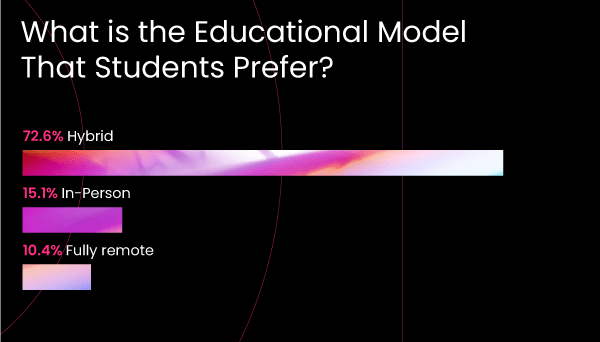Read the full article below (in Italian):


For 68% of Italian students, the perfect training opens up the world of work and connects them to companies. And 72% of students prefer the hybrid educational model.
The data comes from a survey of 1,600 members of the Docsity community by OPIT – The Open Institute of Technology.
OPIT founder Riccardo Ocleppo states: “Students need more practical learning and skills that allow for a faster and more profitable entry into a company.”
Milan, 19 June 2023 – Italian students aged between 18 and 26 prefer educational and training offerings based on the hybrid models and a focus on up-to-date training provided by quality teaching staff. They’re also less likely to believe that the name of a university is enough to guarantee job opportunities upon graduating. These are some of the chief findings to emerge from an OPIT survey of 1,600 students (secondary level and university) who are part of the Docsity community – a platform for sharing documents and interesting content – just a few days before the beginning of final exams.
The results show that students consider job opportunities and connections with companies as the main factors when evaluating study opportunities (68%). Cost is also an important criterion (39.6%), as is the updating of teaching methods and practical aspects of the course to ensure they’re aligned with today’s work environment (33.1%). Furthermore, 21.7% of those surveyed note the quality of the teaching staff as being crucial to helping them absorb the skills they need to succeed as workers in the future. The “name” and reputation of a university of training provider only matters to 13% of those surveyed.
“The data confirms what we had foreseen when we decided to enter the education market,” says OPIT’s founder and director Riccardo Ocleppo. “Involving companies in our programs was a top priority, and their insights were instrumental in designing the modules we created, including what technologies to rely on and the programming languages we work with, for example.”
“By working with companies to design our programs, we’ve found that students both require and prefer a much more hands-on learning experience. This ensures they’re up to date on current technologies, processes, and ways of working when they join a company. So, our goal for our students is that they leave OPIT feeling much more knowledgeable about what employers really need from them.”
As far as learning methods are concerned, students prefer the hybrid model – having the opportunity to participate in face-to-face lessons while retaining the flexibility to access course content online or even via a fully remote model based on their needs. Amongst university students, 72.6% say they prefer the hybrid model, unlike secondary students, who retain a preference for my “physical” styles of teaching.
When secondary students were asked about their choice of university, 46% of boys and girls indicated engineering, computer science, and STEM as their preferred fields. Humanities and communication followed (20.6%), with economics taking the third spot (17.9%).
“Rapid developments in technology and artificial intelligence,” continues Ocleppo, “are creating new job opportunities for STEM graduates, which current students clearly understand. Specific skills are becoming increasingly important as enterprises move more and more to make the most out of the changes brought by AI. Yet, the shortage of tech workers is expected to grow even faster in the coming years. Despite the concern that the wave of AI-inspired technologies is creating, there is no doubt there will be demand for certain types of professionals with specific technical skills.”
OPIT’s data also indicates a widespread trend toward the continuation of studies beyond initial certification, belying the more pessimistic readings on the growth of the NEET (Not in Education, Employment, or Training) phenomenon. Enrolling in a degree course remains both the safest and preferred choice for the majority of secondary school students – 82% confirmed their intention to continue their studies at the university level. A further 8.3% are undecided about university, while 5% will choose short training courses, with only 2.5% of students surveyed saying they’ll stop education after their fifth-grade exams. Accredited training (university, business school, or some other form of higher education) remains the preferred choice of almost all students (94.6%).
Delving deeper into a behavioral analysis of university students, an interesting preference for further continuation of studies emerges. Over two-thirds (68%) say they wish to continue, demonstrating that a Bachelor’s degree alone is not seen as the ideal pathway into the world of work. In fact, of those who declared a willingness to continue studying after submitting their Bachelor’s thesis, 90% said they want to enroll in a new long-term study program – either a second Bachelor’s degree or a Master’s degree. It’s also significant that more university students are undecided about continuing their educations (22%) than those who are convinced they’ll finish studying permanently upon completion of their degrees (10%).
Asked about what will be most important in a future where they will have to grapple with various AI-led transitions, over half of students (56%) believe it’s essential to understand artificial intelligence and its applications. This was followed by digital marketing (42%), with cybersecurity identified by one in three students (35%) as key due to the job opportunities in that field linked to the need to protect growing amounts of personal data. Fintech closed this ranking at 3%.
OPIT – Open Institute of Technology is an academic institution accredited at the European level that provides an exclusively online training offer focused on Computer Science and a teaching staff made up of professors of international standing. OPIT stands out in the panorama of university-level training for a didactic model shaped by the need for quality, flexibility, and connection with the business world of upcoming generations. OPIT’s degree programs are oriented towards the acquisition of modern and up-to-date skills in the crucial sector of computer science. Its degrees are accredited by the MFHEA and the EQF (European Qualification Framework), and professionally recognized by employers.
Related posts

Source:
- Agenda Digitale, published on June 16th, 2025
By Lokesh Vij, Professor of Cloud Computing Infrastructure, Cloud Development, Cloud Computing Automation and Ops and Cloud Data Stacks at OPIT – Open Institute of Technology
NIST identifies five key characteristics of cloud computing: on-demand self-service, network access, resource pooling, elasticity, and metered service. These pillars explain the success of the global cloud market of 912 billion in 2025
Read the full article below (in Italian):

You’ve probably seen two of the most recent popular social media trends. The first is creating and posting your personalized action figure version of yourself, complete with personalized accessories, from a yoga mat to your favorite musical instrument. There is also the Studio Ghibli trend, which creates an image of you in the style of a character from one of the animation studio’s popular films.
Both of these are possible thanks to OpenAI’s GPT-4o-powered image generator. But what are you risking when you upload a picture to generate this kind of content? More than you might imagine, according to Tom Vazdar, chair of cybersecurity at the Open Institute of Technology (OPIT), in a recent interview with Wired. Let’s take a closer look at the risks and how this issue ties into the issue of responsible artificial intelligence.
Uploading Your Image
To get a personalized image of yourself back from ChatGPT, you need to upload an actual photo, or potentially multiple images, and tell ChatGPT what you want. But in addition to using your image to generate content for you, OpenAI could also be using your willingly submitted image to help train its AI model. Vazdar, who is also CEO and AI & Cybersecurity Strategist at Riskoria and a board member for the Croatian AI Association, says that this kind of content is “a gold mine for training generative models,” but you have limited power over how that image is integrated into their training strategy.
Plus, you are uploading much more than just an image of yourself. Vazdar reminds us that we are handing over “an entire bundle of metadata.” This includes the EXIF data attached to the image, such as exactly when and where the photo was taken. And your photo may have more content in it than you imagine, with the background – including people, landmarks, and objects – also able to be tied to that time and place.
In addition to this, OpenAI also collects data about the device that you are using to engage with the platform, and, according to Vazdar, “There’s also behavioral data, such as what you typed, what kind of image you asked for, how you interacted with the interface and the frequency of those actions.”
After all that, OpenAI knows a lot about you, and soon, so could their AI model, because it is studying you.
How OpenAI Uses Your Data
OpenAI claims that they did not orchestrate these social media trends simply to get training data for their AI, and that’s almost certainly true. But they also aren’t denying that access to that freely uploaded data is a bonus. As Vazdar points out, “This trend, whether by design or a convenient opportunity, is providing the company with massive volumes of fresh, high-quality facial data from diverse age groups, ethnicities, and geographies.”
OpenAI isn’t the only company using your data to train its AI. Meta recently updated its privacy policy to allow the company to use your personal information on Meta-related services, such as Facebook, Instagram, and WhatsApp, to train its AI. While it is possible to opt-out, Meta isn’t advertising that fact or making it easy, which means that most users are sharing their data by default.
You can also control what happens with your data when using ChatGPT. Again, while not well publicized, you can use ChatGPT’s self-service tools to access, export, and delete your personal information, and opt out of having your content used to improve OpenAI’s model. Nevertheless, even if you choose these options, it is still worth it to strip data like location and time from images before uploading them and to consider the privacy of any images, including people and objects in the background, before sharing.
Are Data Protection Laws Keeping Up?
OpenAI and Meta need to provide these kinds of opt-outs due to data protection laws, such as GDPR in the EU and the UK. GDPR gives you the right to access or delete your data, and the use of biometric data requires your explicit consent. However, your photo only becomes biometric data when it is processed using a specific technical measure that allows for the unique identification of an individual.
But just because ChatGPT is not using this technology, doesn’t mean that ChatGPT can’t learn a lot about you from your images.
AI and Ethics Concerns
But you might wonder, “Isn’t it a good thing that AI is being trained using a diverse range of photos?” After all, there have been widespread reports in the past of AI struggling to recognize black faces because they have been trained mostly on white faces. Similarly, there have been reports of bias within AI due to the information it receives. Doesn’t sharing from a wide range of users help combat that? Yes, but there is so much more that could be done with that data without your knowledge or consent.
One of the biggest risks is that the data can be manipulated for marketing purposes, not just to get you to buy products, but also potentially to manipulate behavior. Take, for instance, the Cambridge Analytica scandal, which saw AI used to manipulate voters and the proliferation of deepfakes sharing false news.
Vazdar believes that AI should be used to promote human freedom and autonomy, not threaten it. It should be something that benefits humanity in the broadest possible sense, and not just those with the power to develop and profit from AI.
Responsible Artificial Intelligence
OPIT’s Master’s in Responsible AI combines technical expertise with a focus on the ethical implications of AI, diving into questions such as this one. Focusing on real-world applications, the course considers sustainable AI, environmental impact, ethical considerations, and social responsibility.
Completed over three or four 13-week terms, it starts with a foundation in technical artificial intelligence and then moves on to advanced AI applications. Students finish with a Capstone project, which sees them apply what they have learned to real-world problems.
Have questions?
Visit our FAQ page or get in touch with us!
Write us at +39 335 576 0263
Get in touch at hello@opit.com
Talk to one of our Study Advisors
We are international
We can speak in:


